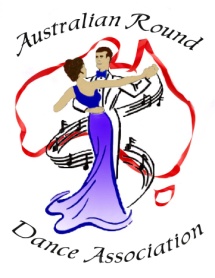
|

|
| Home Page | Management Committee | Cuers & Clubs | What is Round Dancing? | Latest News | Cue Sheets | States | Contact us |
ROUND DANCINGA Simple ExplanationRound Dancing is simply couple dancing that uses most rhythms from ballroom. These include waltz, foxtrot, jive, cha cha, rumba, tango, quickstep and more. This style of dancing is a non-competitive couple recreation open to anyone ... even those who have had no previous dance background. It has proved to be easily learned through lessons ... even by those who consider themselves "as having two left feet". A Detailed Explanation (from the Sears website - see below)Round dancing is choreographed and cued ballroom dancing. We dance most of the popular ballroom rhythms, such as foxtrot and waltz, cha-cha and rumba, and many others. There is certainly no need to get bored with round dancing. The exciting difference between round dancing and free-style ballroom dancing is that each round dance has been fully choreographed ahead of time. A beautiful piece of music is selected, and the different steps or figures are chosen to fit the music exactly. If the music swells and pauses briefly, then a dance step that rises and stretches is put into that place. If there is a little syncopation in another part of the song, then a quick little step is inserted. The creation of a piece of choreography is like engineering a machine, with every gear and lever in just the right place to give smooth and flowing motion. The step-by-step instructions on how to dance this choreography are written out in what is called a "cue sheet." Secondly, there is a cuer or leader at the front of the ballroom who tells the dancers what steps to do. As the music plays, and just ahead of the beat, so the dancers have time to respond, the cuer names each dance figure in the choreography. The cueing lets us dance lots and lots of dances without having to memorize the choreography. You may recognize that this is the way square dancing is done, with a caller telling the couples what to do: “swing your partner, do-si-do.” In round dancing, the cuer might say: "open telemark, pick up, and diamond turn." But compare this round dancing with free-style ballroom. In ballroom dancing, the man has to think of what figures he wants to do to this music and then he has to lead the woman to do those figures. Not all men are sharp enough to do at least three things at the same time: think up the choreography, make his feet do what he has thought up, and lead the lady to do it with him. When I ballroom dance, I can usually think of maybe a half-dozen different things to do, and then we do them over and over. Meredith whispers, “Let’s do something different,” but my mind is a blank. So, for the man, the round dance cuer is a saviour. Someone else has thought up what steps should be done to this particular piece of music. The choreographer has carefully studied the music ahead of time and has selected just the steps that best fit each measure of music, and the cuer reminds us what we should do as we dance. Instead of only 6 or 8 different steps, that I could think of myself, a round dance might easily have 30 or 40 different figures. No, we certainly don’t get bored doing the same steps, over and over again. And then the next dance of the evening will contain a different selection of figures, arranged in ever varying combinations. Literally thousands of round dances have been choreographed over the years, and every one is unique. What other hobby provides such richness, such mental and physical challenge, and at the same time allows you to hold a beautiful (or handsome) partner in your arms all the while? This article is a portion of the Sears web site "What is Round Dancing". Return to Home Page |
|